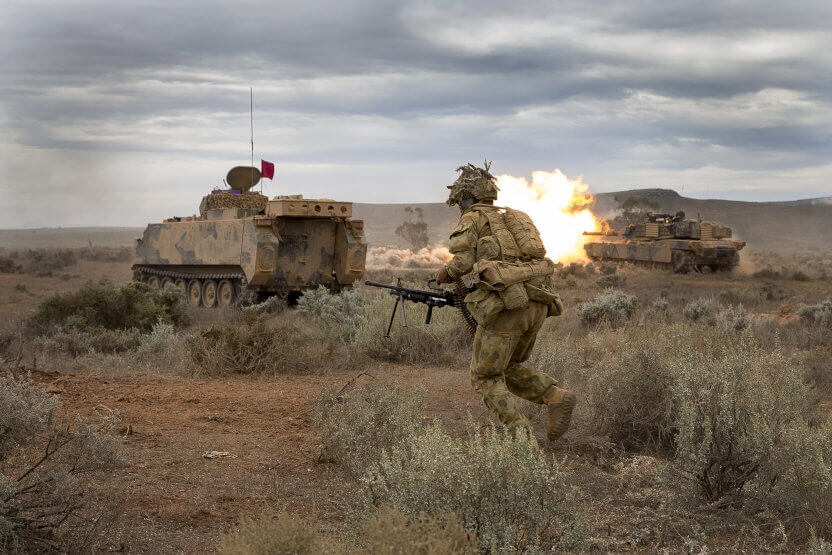Minsiter for Defence Industry Christopher Pyne has announced the three capability streams set to take priority in the 2016-17 financial year.
Speaking at the Land Forces Conference in Adelaide yesterday he stated:
There’s an old axiom that to prioritise everything is to prioritise nothing, and so tonight I would like to announce the three innovation priorities for the Innovation Hub.
As you would know the Integrated Investment Program identified six capability streams.
Of these, the top three priorities for financial year 2016-17 are as follows.
In the Intelligence, Surveillance, Reconnaissance, Electronic Warfare, Space and Cyber capability stream we will focus on improving intelligence collection, analysis and dissemination.
This will also include biometric data, as well as cyber innovation to support intelligence capability development.
The step change from Intelligence, Surveillance and Reconnaissance to Targeting, as well as the advancement of hypersonic technology as an opportunity for Defence’s space capabilities, also warrant attention in this stream.
In the Key Enablers stream, one which I am glad is now seeing the attention it deserves, we will focus on the need to update command and control systems across all domains spanning the strategic to tactical levels.
Innovation opportunities were also recognised in the Force Structure Review in strategic and satellite communication, simulation and further research into energy resilience.
And finally, in the Land Combat and Amphibious Warfare stream we will focus on remotely operated platforms, the Armed Reconnaissance Program, nanotechnology and, in support of close quarters combat, the Special Forces and Soldier Systems programs.
Of course, the beauty of innovation is that we do not yet know what great ideas or fields will yield us the most success, and so we will keep a handy reserve to proposals that do not neatly fit into the priorities but nonetheless offer us an opportunity to explore unexpected or unforeseen technologies or ideas.
These three priorities present a wealth of opportunities for industry to work with Defence and state and territory governments to grow our technological edge.
The acquisition of the 1100 Hawkei light protected vehicles and 1000 companion trailers, to take one example, will create many opportunities for our defence industry to be involved by ensuring at least half of the cost of the vehicle’s manufacture will be spent in Australia.
With the Hawkei production taking place at the Thales factory in Bendigo we will see the benefits of this investment being shared with around 170 people employed in the region.
Another is the contracts I announced less than a fortnight ago between BAE Systems Australia, Rheinmetall and the Commonwealth for the next stage of the LAND 400 Phase 2 – the Risk Mitigation Activity – which will test the two company’s options for our next Mounted Combat Reconnaissance Capability.
This will not only see the procurement of world class vehicles that offer a quantum leap in protection for our soldiers and our military operation capability, but a focus on increasing the opportunities for Australian industry involvement in the project.
There will also be new equipment for the individual soldier, such as the 30,000 enhanced F88 weapons systems – lighter, modular and with improved ammunition interoperability. Thales Australia will produce the rifle in Lithgow, New South Wales.
It will stretch to the parade ground and boots supplied by one of our national icons, R M Williams, first made in a shed a brisk walk from here and still proudly manufactured in Adelaide’s north.
And it will be felt in the way defence contracts a range of services essential to support our defence bases from facilities management and logistics through to catering and domestic services.
Ten comprehensive Base Services Contracts now manage all of these right across Australia – not just delivering value for money but crafted to enable small to medium enterprises to be engaged to the maximum extent possible by the lead contractor, providing an economic boost to local economies from the more than $1 billion spent and 11,000-plus direct and indirect jobs they provided.
And, of course, there is the $267 million being spent on the facilities to support the new LAND 121 vehicle fleet, which includes the G-Wagon light vehicles, the Rheinmetall MAN trucks, and the Thales Hawkei vehicle. Expenditure during the next three years will create many opportunities for local subcontractors over and above the already strong Australian industry involvement in the manufacture and delivery of the LAND 121 vehicles themselves.
All of these are great examples of how Defence is already working with Australian industry.
Click here to read Mr Pyne's full speech.


